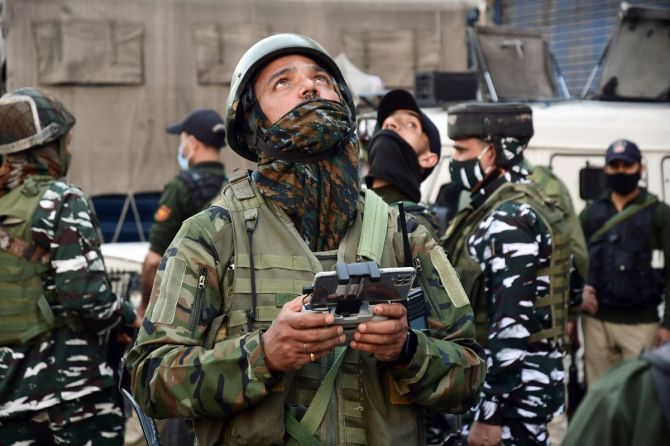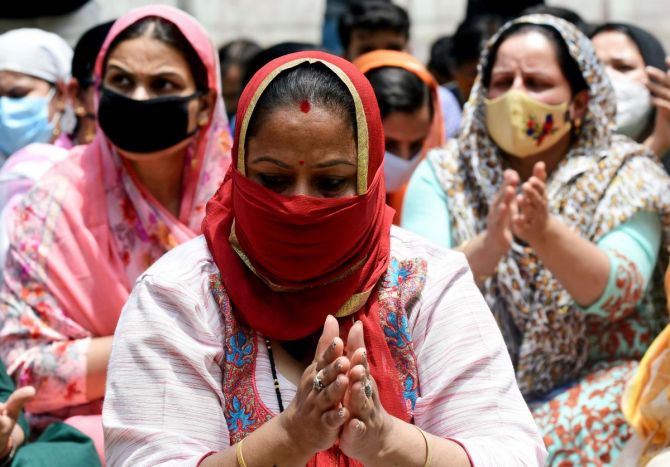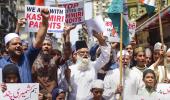In the Kashmir Valley, we need to begin to make a distinction between an insurgent who fights the security forces and a terrorist who murders unarmed civilians, suggests Colonel Anil A Athale (retd).

The recent spurt in targeted killings that signalled the rise of terrorism in the Kashmir Valley has put a sharp focus on the Indian Army's shortcomings in evolving a suitable doctrine to tackle the Kashmir issue.
Let us accept that as the premier agency dealing with Kashmir, it is the army that gives major inputs to decision makers at the highest level. At that level, we seem to have clearly divided the Kashmir issue into external and internal.
For the external dimension, since the last eight years or so, we have evolved a policy of counter force to target terrorist camps across the border.
To check infiltration, we have erected border fences and a three tier defence to impede, obstruct and neutralise terrorists who sneak across the border.
This has been successful in bringing down the number of foreign terrorists to a very small number.
For the second aspect of home grown insurgents, we have evolved a policy based on winning hearts and minds through economic development and good governance and hunting down the perpetrators of violent crimes post event.
Yet the sad fact is that we are failing to check the targeted killings of minorities, government supporters and innocent bystanders.
The terrorist aim is to disrupt economic development and carry out ethnic cleansing, forcing random State violence and thus gain more recruits internally for terrorist acts.
My 25 years of study of insurgency and terrorism in diverse countries/locations like Northern Ireland, Kashmir, Sri Lanka, Punjab and South Africa (during the apartheid regime) has yielded some interesting insights into the phenomenon.
In all the above-mentioned struggles, 'terrorism' was used as a tactic some time or the other.
In every insurgency/terrorism, there are three elements -- leadership, organisation and cause/ideology.
These three elements are not static and their inter se relationship/importance is constantly changing in both time and space.
For instance, in the current phase of the Kashmir insurgency, the period before 2014 saw a prominent role being played by the leadership of Syed Shah Gilani as well as the Hurriyat Conference.
In the subsequent phase, it was the Hizbul Mujahideen and Lashkar e Tayiba that gained prominence.
As the terrorist leadership got decimated and its organisation disrupted by military action, 'lone wolf' attackers emerged on the scene.
But at the strategy level, the approach has to be three-pronged, to aim at the cause, leadership and organisation.
Weakening of only one or even two facets does not result in peace.
Counter terror operations for the last 15 years or so have achieved some success in killing the leaders and disrupting terror organisations.
However, due to the 'politically correct' approach to religion, the ideology of the terrorists has never been seriously questioned.
All this while the cause of converting Kashmir a (mythical Islamic State) into Dar al Islam (from its current Dar al Harb) has continued unchallenged.
The idea of geographical divisions along religious lines -- the dar -- is not mentioned in the Quran or Hadith.
The only 'dar' the Quran speaks of is 'the abode of the Hereafter (heaven) and the earthly life', with heaven described as clearly superior to life on earth.
This makes it obvious that what is claimed as sanctioned by religion is actually a 'political' tool that is being used by some elements/nations.
Indian Muslims must come together and question the two concepts of Dar al Harb and 'kufr' (non-believers).
It is these two concepts that are at the root of motivation of Islamic terror.
In order to effectively deal with this falsehood that has crept into Islam due to historical reasons (when religion was used as a tool to spread an empire), it is necessary to denounce these concepts as un-Islamic and ex-communicate those who profess these notions.
In short, the kind of treatment that the world of Islam gives to the Ahmadiyyas and treats them as un-Islamic and even 'wajib e katl' (fit for assassination) has to be instead applied to its own radical and hate mongering cults.
In short, one is advocating a clear split between the majority of peace loving Muslims and its radical/intolerant part.
This is a historical necessity and is not a new phenomenon as many other faiths (including Islam) have indeed undergone such convulsions in history.

The second agenda point is to put curbs on the means to carry out hate propaganda by Islamic radicals.
More and more cases have come to light wherein many lone wolf attacks have been carried out by persons who got radicalised on the Internet.
It is time to put the Internet under some sort of control.
The contents of cyberspace need to be monitored and any posts/communications that are detrimental to peace and harmony should be deleted and such individuals/organisations be banned from the use of cyberspace.
Vladmir Lenin, the father of the Russian Revolution, is often quoted as having said that 'Ideas are even more fatal than guns', so if we do not permit easy access to guns to all and sundry, then why should we permit the same freedom in the realm of ideologies that propagate violence and are a danger to humanity?
The rise of global media outlets like Facebook, WhatsApp and Twitter etc have empowered individuals at the cost of society.
Freedoms have to be used responsibly. There is no real option to imposing reasonable curbs on cyberspace.
Like child porn is monitored, so should be hate posts. While child pornography is criminal, so is terrorism and merits the same treatment.
The sad truth is while technology has progressed to give unlimited opportunity and freedom to human beings to communicate, human development has lagged far behind.
Mindsets and attitudes of many betray a medieval mindset.
In such a situation, absolute freedom enjoyed in cyberspace is dangerous and needs to be put under some form of control.
The final agenda point is regarding the human rights of terrorists. For too long, this has been a one way street.
While the terrorists do not treat their victims as human beings, the counter terrorists are expected to follow humane tactics and procedures.
This gives an unfair advantage to the terrorists when it comes to a confrontation.
Any soldier/policeman will tell you that in such situation, with one hand tied behind one's back, it becomes impossible to effectively deal with terrorists.
With the terrorists increasingly using sophisticated arms, it is the more unscrupulous that stands to win.
At the ground level, this is in any case already happening.
It is time the world human rights organisation deliberates on the issue and decides to deprive terrorists of their human rights.
If the terrorists do not believe in humanity and act in an inhuman manner, why should they be treated as human beings?
In the Kashmir Valley we need to begin to make a distinction between an insurgent who fights the security forces and a terrorist who murders unarmed civilians.
While the former's family needs to be spared, the latter's supporters/family must pay the price.
This is the only way to deal with terrorists, and not by putting more guards or shifting people to protected ghettos.
Colonel Anil A Athale (retd) is a military historian whose earlier columns can be read here.
Feature Presentation: Aslam Hunani/Rediff.com











 © 2025
© 2025